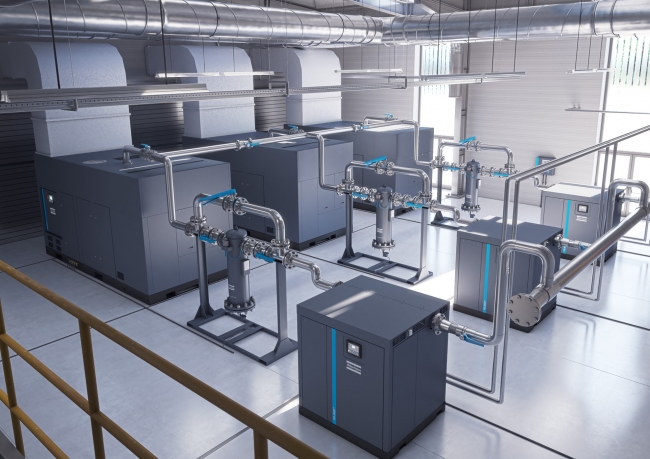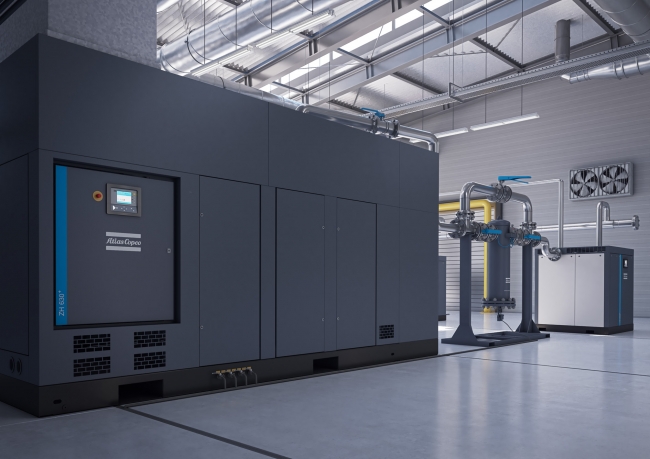5 minute read • published in partnership with Atlas Copco
Insight: Why the time is right to consider turbo compressor technology
Large-scale, high-energy applications like glass processing, food processing, steel manufacturing and petrol-chemicals face similar challenges to other industrial concerns. However, as Michael Pingram from Atlas Copco explains, they face an added dimension: their size means that any failure to address such challenges promptly and efficiently will incur correspondingly scaled-up consequences and costs. For example, an unscheduled production stoppage could easily cost thousands of pounds an hour.
Compressor energy and other life cycle costs
This magnitude factor becomes particularly apparent when implementing, managing or upgrading compressor installations. Controlling energy costs is an obvious concern, not only because of steadily rising electricity prices, but also because of social and legislative pressures to go green. The problem is exacerbated in applications where the air flow demand is varying or unpredictable.
While important, energy costs are not the only issue. Crucially, users need to also consider the total lifecycle costs of a compressor installation. Buying in a large compressor, or set of compressors, is a significant investment decision, which is rarely implemented due to the costs involved. This pressure can make the procurement process particularly stressful and prone to error if it has to be conducted through third-party contractors, none of whom can offer a clearly-defined, off-the-shelf solution. Consultants can be employed, but this raises concerns about high consultancy fees.

For large-scale, high-energy applications an unscheduled production stoppage could easily cost thousands of pounds an hour / Picture: Atlas Copco
Next, there are practical considerations related to operation and installation. High-capacity compressors are large machines, so minimising footprint is important. Could a couple of advanced models replace a larger bank of older-technology compressors? Furthermore, how clean is their compressed air output; considering that modern manufacturing might call for class 0 air?
Last, but not least – considering the possible consequences of any compressor downtime – there’s a requirement for reliable, effective and fast maintenance support. The compressor supplier must demonstrate a solid, UK-wide service infrastructure that offers not only rapid callout capability for emergencies, but also predictive or preventative maintenance strategies that allow developing faults to be identified and repaired before they can cause failures.
How users can benefit from turbo compressors
Turbo compressors – otherwise known as centrifugal air compressors – deliver high energy efficiency and flow rates for the industries mentioned, and other large-scale, high energy enterprises. These compressors provide up to 36,000 m3/hr capacity with packages from 355kW to 3.1MW. Crucially, they can be delivered as a single, integrated ‘commercially off the shelf’ package with auxiliary systems included.
This type of single-source, packaged solution offers many further benefits. Without need for research and design expenditure, project costs are reduced. Various impeller types, along with motors, coolers, silencers and air filters can be designed by the compressor manufacturer without the complexity of third-party contractor involvement. Savings from these benefits can amount to 15-20 per cent of a machine’s value, depending on the project.
Energy efficiency
Centrifugal compressors offer unbeatable energy efficiency in process air or bulk air applications presenting a flat load or when providing a baseline flow in mixed installations with VSD screw compressors. This due to their ample-sized cooling, low pressure drops and an efficient drive train.
Instead of adding extra compressors for expansion projects, a bank of older compressors can be replaced with just a couple of centrifugal types. Combining several flow rates into one or two reduces service costs, while easing regulation and monitoring. In one instance 26 compressors were removed from a glass manufacturing installation and replaced with seven turbo machines. This saved £40k a month in electricity costs, while also significantly reducing the earlier machines’ £65k servicing bills.
The example below demonstrates centrifugal compressors’ significant energy advantages over screw types. In it, a centrifugal compressor is compared with a screw compressor pair, where both solutions are rated at 900 kW, while operating under reference conditions of 7 bar, 20°C, 0%RH and 1 atmosphere inlet pressure.
• The pair of screw compressors combine to deliver a total of 146m3/min at 7 bar, with an average SER of 7.13 kW/m3/min
• By comparison, the single turbo compressor could deliver approximately 189 m3/min with a SER of 5.044342 kW/m3/min. Accordingly, the turbo solution makes up to 29% more free air delivered (FAD) available while also reducing the SER by 29%.
• Alternatively, the centrifugal compressor could be run at 146m3/min, to match the combined screw compressor output, while reducing SER by 28%.

Centrifugal compressors offer unbeatable energy efficiency in process air or bulk air applications / Picture: Atlas Copco
Oil-free air technology
Many applications require absolutely clean air to avoid product contamination and costly downtime. Manufacturers have responded to this need by developing oil-free compressors and blowers. Compressors must meet or exceed ISO 8573-1 CLASS 0 specifications in order to satisfy their 100% clean air requirements. The TÜV Institute tests compressors against the ISO standard to verify compliance. They measure all possible oil forms across a range of temperatures and pressures. The ideal scenario is where TÜV finds no traces of oil in the output air stream.
Service and support
Investing in a single source packaged solution gives users access to a whole lifecycle service and support strategy.
This starts with the buying cycle. The packaged solution approach streamlines the consultation process. Design engineers can focus entirely on the user’s application requirements instead of integrating multiple vendor solutions. This begins with checking the space available for the installation, and assessing the flow and pressure requirements.
More advanced calculation tools can then be deployed as required. A performance estimate can be generated to analyse customer reference and operating conditions. Energy audits involve running a data logger for a week to analyse compressed air usage patterns. The resulting, detailed report outlines where running efficiency improvements or energy savings could be made and highlights any non-conformance with ISO standards.
Once delivered to site, start-up can be rapid and fault-free; with all ancillary components already packaged, no on-site assembly is required.
For ongoing operational support, Atlas Copco has the world’s largest compressor service infrastructure, and has installed 13 MW of compressor capacity over the last 2½ years. This means that Atlas Copco technicians and components are always easily accessible to users anywhere in the UK.
